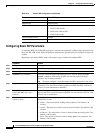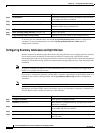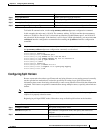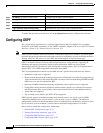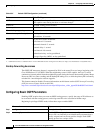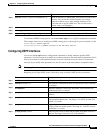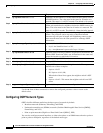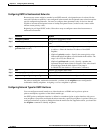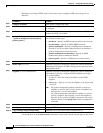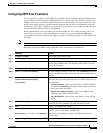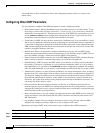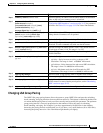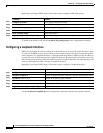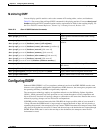
35-28
Cisco ME 3400 Ethernet Access Switch Software Configuration Guide
OL-9639-06
Chapter 35 Configuring IP Unicast Routing
Configuring OSPF
Use the no form of these commands to remove the configured parameter value or return to the
default
value.
Configuring OSPF Network Types
OSPF classifies different media into the three types of networks by default:
• Broadcast networks (Ethernet, Token Ring, and FDDI)
• Nonbroadcast multiaccess (NBMA) networks (Switched Multimegabit Data Service [SMDS],
Frame Relay, and X.25)
• Point-to-point networks (High-Level Data Link Control [HDLC], PPP)
You can also configure network interfaces as either a broadcast or an NBMA network and as point-to
point or point-to-multipoint, regardless of the default media type.
Step 8
ip ospf hello-interval seconds (Optional) Set the number of seconds between hello packets sent on
an OSPF interface. The value must be the same for all nodes on a
network. The range is 1 to 65535 seconds. The default is 10 seconds.
Step 9
ip ospf dead-interval seconds (Optional) Set the number of seconds after the last device hello
packet was seen before its neighbors declare the OSPF router to be
down. The value must be the same for all nodes on a network. The
range is 1 to 65535 seconds. The default is 4 times the hello interval.
Step 10
ip ospf authentication-key key (Optional) Assign a password to be used by neighboring OSPF
routers. The password can be any string of keyboard-entered
characters up to 8
bytes in length. All neighboring routers on the
same network must have the same password to exchange OSPF
information.
Step 11
ip ospf message digest-key keyid md5 key (Optional) Enable MDS authentication.
• keyid—An identifier from 1 to 255.
• key—An alphanumeric password of up to 16 bytes.
Step 12
ip ospf database-filter all out (Optional) Block flooding of OSPF LSA packets to the interface. By
default, OSPF floods new LSAs over all interfaces in the same area,
except the interface on which the LSA arrives.
Step 13
end Return to privileged EXEC mode.
Step 14
show ip ospf interface [interface-name] Display OSPF-related interface information.
Step 15
show ip ospf neighbor detail Display NSF awareness status of neighbor switch. The output
matches one of these examples:
• Options is 0x52
LLS Options is 0x1 (LR)
When both of these lines appear, the neighbor switch is NSF
aware.
• Options is 0x42—This means the neighbor switch is not NSF
aware.
Step 16
copy running-config startup-config (Optional) Save your entries in the configuration file.
Command Purpose



